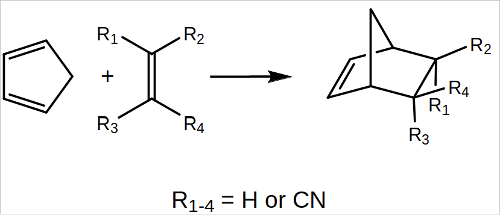Speaker
Description
The polar Diels-Alder (P-DA) reactions between cyclopentadiene and the cyanoethylene series, experimentally studied by Sauer, have been studied[1] within the Molecular Electron Density Theory (MEDT)[2], which establishes that changes in electron density, but not molecular orbital interactions, are responsible for organic chemical reactivity. Accordingly, any study of reactivity within the framework of MEDT rules out the use of molecular orbitals to interpret reactivity and makes use, instead, of quantum chemical tools based on the analysis of density functions, such as the electron localisation function (ELF)[3] or the electron density itself through the Quantum Theory of Atoms in Molecules (QTAIM)[4] and Conceptual DFT (CDFT)[5].
CDFT analysis of the global and local electrophilicity power of these series of cyanoethylenes explains the increase of reaction rates with the increase of electron-withdrawing -CN substitution, as well as the (a)synchronous nature of the single bond formation process. The quantum topological energy partitioning method known as Interacting Quantum Atoms (IQA)[6] allows establishing that the global electron density transfer (GEDT)[7] taking place at the polar TSs is the main factor responsible for the experimentally observed acceleration, by favouring the bond formation processes. The combination of IQA with the Relative Energy Gradient (REG) [8] method along the reaction path, known as REG-IQA, reveals that while the rupture of the multiple bonds is the factor most contributing to the barrier, the favourable interactions in the forming single bond regions account for the driving force of the reactions.
In this talk, besides exploring the application of some of the quantum chemical tools most frequently used in MEDT studies, the new rationalization of these relevant experimental organic reactions within MEDT will be discussed.

References
[1]L. R. Domingo, M. Ríos-Gutiérrez, Submitted (2023).
[2]L. R. Domingo, Molecules, 21, 1319 (2016).
[3]A. D. Becke, K. E. Edgecombe, J. Chem. Phys., 92, 5397 (1990).
[4]R. F. W. Bader, Atoms in Molecules: A Quantum Theory, Clarendon Press, USA (1994); R. F. W. Bader, H. Essén, J. Chem. Phys., 80, 1943 (1984).
[5]R. G. Parr, W. Yang, Density Functional Theory of Atoms and Molecules; Oxford University Press: New York, NY, USA (1989); L. R. Domingo, M. Ríos-Gutiérrez, P. Pérez, Molecules, 21, 748 (2016).
[6]M. A. Blanco, A. Martín Pendás, E. Francisco, J. Chem. Theory Comput., 1, 1096 (2005).
[7]L. R. Domingo, RSC Adv., 4, 32415(2014).
[8]J. C. R. Thacker, P. L. A. Popelier, Theor. Chem. Acc., 136, 86, (2017).
